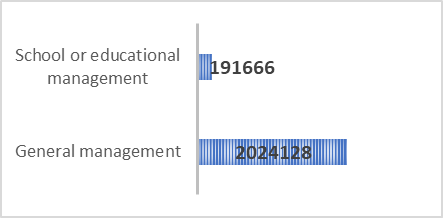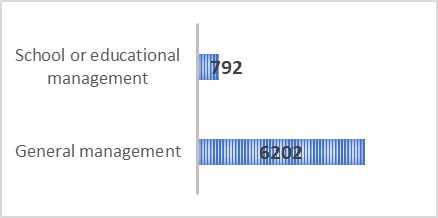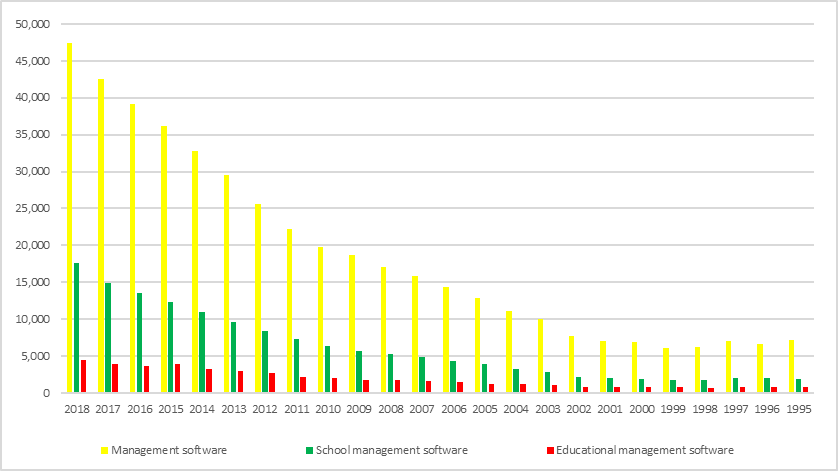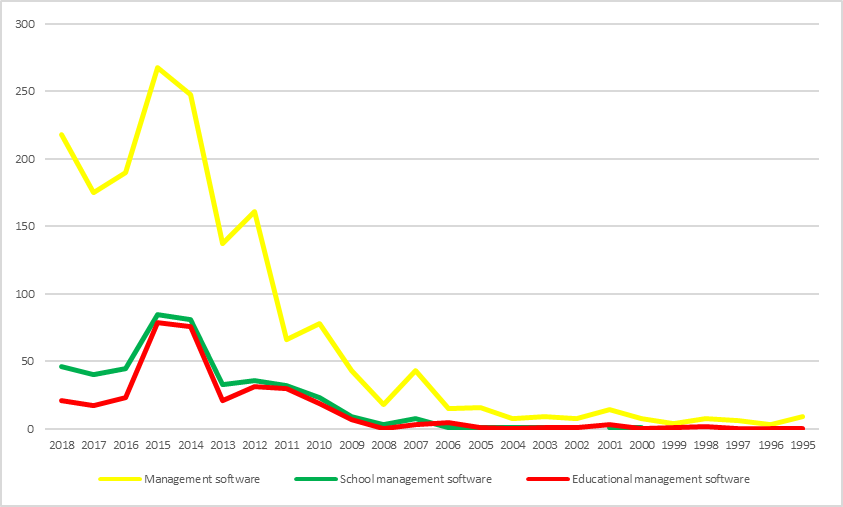Abstract
As in any other field, the education industry has begun to use technology to its advantage in order to optimize. Education institutions around the world are looking to maximize productivity using the resources available to try to eliminate gaps in the system that can greatly influence their development. New solutions have emerged that allow us to review, understand and prepare the premises for better school management. Education management software is used by teachers, students, and school administrators for organization and collaboration, and to facilitate learning. With the efficient use of school management software, school maintenance and management has become much easier. Thus, management software has different meanings depending on the educational ways it is trying to figure out. To make school operations more efficient, education management software is used in a variety of academic and management-related tasks. This paper aims to be an analytical and comparative study on how software programs are used in educational management. Statistical data have been acquired, filtered and analysed on the attractiveness and interest in digital management solutions in general and educational management in particular. At the same time, the authors present both the advantages and disadvantages of these solutions. The statistical data presented in this study reflects the international research, but also the impact of the educational management software solutions in Romania.
Keywords: Educational managementscholar managementsoftware solutionanalytical study
Introduction
The human being as a social being is obliged to live in communities that have a structure, a certain degree of organization, a system of institutions and, inevitably, a hierarchy. This latter aspect induces subordination relationships, sometimes the most complex. School as a fundamental social institution, is a social body that repeats the structure and functioning of a community. The educational management is a segment of the general theory of management, but it also has particular aspects that define it and differentiate it from other sectorial approaches.
Today, the manager is more than a leader. His responsibilities is it an arts and science in organizing, commissioning, optimizing, and intervening in the work of an institution with major social impact and with a broader or narrower collective.
Management meant to driving and finding solutions. This conception can also be applied to the educational process, where the director, or in other words, the school manager has the difficult task of identifying the most effective ways to lead and promote the school image (Ortan, 2004).
Due to the socio-cultural context, the status and role of the school manager has become increasingly complex. The school manager must be properly trained because expects good decisions, good organization and optimization of the instructive-educational process.
"Scholar performances as well as the methodological and professional performances of the students are influenced by the overall activity of the school manager" (Ortan, 2004).
Two kind of managers can be distinguished in the school organization: the manager of the institution and manager of the class (Kaplan, 2014):
The school manager is not just an administrative manager, he is the coordinator of the all activity in the unit school, but in administrative, financial and accounting sense, as well as in the instructive-educational sense.
The teacher that is the manager of the class - conducts many activities directly and autonomously, either at the level of the group of students or at the level of the class or at the school level. He is in a continuous relationship with students from the educational, formative perspective.
Next, in the second part of the paper are presented the issue of digital systems in educational management, in the third part it is presented the analysed directions, as well as which functions of the school management can be replaceable by software application. In the last two sections, 4 and 5 respectively is presented the result of a use case and evolution of scientific research on educational management are presented.
Problem Statement
Even though the digitization of documents ensures productivity gains, there are still many areas in which only print-based continue to be used, which are resource-intensive consuming. In fact, current international and national legislation does not encourage the use of software solutions, requiring archived by physical storage of important documents (Bennis, & O’Toole, 2005; Elena et al., 2017) Among the most important benefits of implementing of a management software system can be follows: reduced storage space; lower costs; instant access to documents; correct indexing of documents; high security, traceability.
"Digitizing and managing the documents allows them to be centralized, increasing the speed of searching and retrieving information by structuring it. Also, by interconnecting multiple devices can be instantly processed the data." The global educational software market will reach 70.62 billion dollars by 2020, according to a global study, 8.1% global rate (Compound Annual Growth Rate). Adopting such solutions contributes to proactive learning and development of new technologies, strategic alliances and partnerships. Although the educational software market has a bigger impact in the area of higher education, especially universities, schools and kindergartens started to adopt such solutions for the efficiency of educational processes. Technology is becoming more and more used in the education process because students and teachers ask for it. In the on-line environment, there are several software applications dedicated to schools and kindergartens that ensure efficiency at both administrative and educational levels and to encourage the diversification and development of learning process.
Research Questions
In this article, is proposed the analysis of the software applications dedicated to school management. This analysis is based on statistical data and presents the advantages and disadvantages of using such software. Management functions, some of which are found in software applications, are structured and identified from "the cycle of the managerial process, which begin by purpose definition, continuing with task setting and ending with fulfilment" (Erno, 2000, p.16). Establishing the functions of educational management in relation to the specifics of education and school institutions allow their classification as follows: (Ortan, 2004; Ioan, 2002; Ioan 2008; Serban, 2001; Laura & Marina, 2015)
Forecasting (planning);
Organization;
Motivation;
Command;
Coordination and motivation of staff;
Evaluation and control;
Decision.
Of these functions, software applications can help managers in educational institutions to plan and organize activities, but also to evaluate the results. The data provided by educational management software applications will lead to the best and quickest managerial decisions.
Purpose of the Study
The paper represents a comparative scientometric study of top-level scientific publications in school and educational management series. This study is the main personal contribution of the authors.
After analysing the data from this scientometric study, we can find answers to important questions about software programs dedicated to educational management. A few of this basic questions are:
What a dedicated application offer?
-
Manages the activity of each enrolled student so that the manager has a clearer view of the educational actions and the amount of information that the student receives
-
Managing the student-parent relationship-education relationship
-
Tutor-educator / teacher communication facility
-
Effective resource management that addresses the activity of each student
-
Highlight and list on printed forms issued by MEC various certificates, diplomas and certificates
-
Generate tests that allow the user access to an electronic collection library
-
Allows you to edit your own item or change all selected items
-
Evaluates tests
-
Helps actively to browse the content of an electronic collection
-
Provides multimedia packages designed in accordance with the curriculum
-
Provides the possibility for the budgetary units to carry out the budget execution, to draw up the commitments and to track the expenditures on budget items.
What are the benefits of a software application for schools and kindergartens?
Including technology in education make possible to use several interactive learning tools that favour an effective and dynamic learning process (Tudor, 2016). Applications with a role in managing the activity of educational establishments:
Increase accessibility to issues related to child education from the parent perspective
Creating a constant relationship between the tutor and the educator / teacher by collecting feedback and suggestions regarding possible improvements of the educational act, the needs of the children or adapting it to the requirements of the unit
Efficiency of cost centres per education unit
Managing the constant or optional activities that a child has access.
The advantages of educational applications, used exclusively in the development and stimulation of the educational
Educational software applications devoted exclusively to the pupils' learning process have a number of advantages as follow (Soare, 2016; Claudiu & Dumitru, 2016):
The possibility of proactive learning: dedicated software applications provide the opportunity to the learner to learn by themselves and to deepen those aspects of his particular interest.
Students can develop new skills
Students have access to multiple resources
Learning is based on collaboration
The student is always up to date with the news
They are easy to install and have a friendly interface
Stimulates practice and learning through the game
What are the costs of deploying such?
For educational applications, the cost of a license for software applications starts from a few tens of dollars for applications that include educational games and useful information, and can reach hundreds or even thousands of dollars for complex applications that involve studying concepts, developing motor skills, reflexes and reactions, learning and playing through the game. For applications with a role in kindergarten activity managing, the costs depend on the number of users, the access to the modules and the payment method proposed by the software company.
A second objective, which is also a personal contribution of the paper, is to present a use case analysing for the attractiveness level of management software in general and educational management in particular. Attractiveness is considered to be closely related to scientific research in the field. Following the study, can be drawn conclusions on the attractiveness level of these types of programs.
Research Methods
Beginning in the second half of the 20th century, and continuing increasingly, in the context of the global evolution of society, education is experiencing an unfamiliar development for previous epochs. Under the impact of society's demands, in turn generated by the development of human knowledge and technology, education demands a growing amount of resources and, at the same time, is a factor with an important role in the development of other social subsystems (Purnuş & Bodea, 2015; Manea, 2015). The scientific interest in scholar management, which expresses the effectiveness that takes place into the educational system and beyond it that reflect the increasing frequency of research regarding the development of software solutions for the educational management process.
The quantitative evolution of scientific research on educational management demonstrates intense concerns of researchers, the results being disseminated in scientific articles published in specialized journals, monographs, courses, thesis or scientific papers presented at international scientific events. In the following, it is present the results of a statistical survey regarding the international and national management research which includes directions / variables / indicators of statistical analysis as follows:
The frequency of scientific concerns with reference to general management;
The frequency of scientific concerns about software for management;
The frequency of scientific concerns regarding school management;
The frequency of scientific concerns about software for school management;
The frequency of scientific concerns about educational management
The frequency of scientific concerns about software for educational management;
In this case the variables are keywords: general management, the software for management, the school management. Statistical indicators are represented by the number of journalistic appearances within the ScienceDirect database. These values can be found in books, articles published in specialized journals, volumes of conferences, encyclopaedias or patents.
Statistical data was collected using the ScienceDirect database. The data obtained from this database gives us an insight into the level of advanced scientific research in the studied field. I mention that Science Direct provides detailed searching possibilities by author, title, etc. By extending the study to the data bases with general access, like GOOGLE, we can also get an overview of the general interest (application types, cost, usage, etc.) to such applications.


Figure
Figure


A conclusion drawn from this context of research is the short number of publications that reflect the field amplitude of dedicated management software: education or school.
The comparative analysis of data regarding the evolution of scientific publications in the field of management software confirms our intuitive assumption that although the number of publications on management software programs is very modest, there is an increase in the scientific interest in the studied problem
Findings
The results of the quantitative statistical research show the similar elucidation of the scientific interest for the university evaluation, the school evaluation (students' perspective) remains very little studied.
In a more in-depth analysis of the data from the Table
From the perspective of the management software, from 19753 publications in 2010 to 47401 publications in 2018;
From the perspective of the school management software, from 6355 publications in 2010 to 17599 publications in 2018;
From the perspective of the educational management software, from 1976 publications in 2010 to 4472 publications in 2018;
Certainly, study data shows that management software solutions are in line with the development of IT. The large amount of information that a manager manages to drive naturally to the development of software applications in close co-ordination with reality. At the same time, the development and use of software applications is closely related to the development of computer infrastructure in the school domain. This may be an explanation of the low interest in the topic addressed in Romania, compared to the rest of the world (the study shows that: 0.39% of the general management papers are written by Romanian authors, 0.31% of the papers in the school management software area are written by Romanian authors, respectively 0.75% of the articles in the field of educational management software are developed by Romanian authors). This is an additional argument in favour of defining the purpose of our research that focuses on the role of management software solutions in school or educational, prerequisites which logically imply the need to use such programs in the management act.
Conclusion
Analysing the themes of the publications, we mention that the studied sources mainly reflect the interest for the management software concept, to the statistical detriment of the presentation of management software solutions.
In conclusion of the quantitative examination of data about scientific publications on management software, we mention that the results of 2018 are not the final values, because many publications are in the process of being published. Over the past eight years, there has been a steady increase of 7% to 15% worldwide, for all three directions: management software, school management software, educational management software. By comparison, in Romania, we have very high oscillations, with 145% growth, but also with 47% drops. This can be seen as a lack of managerial culture, both the general management and the educational management. Romania has not defined its own educational management. The Romanian education system is still in the search for identity and this also affects the educational management. The concept of management software application has seen development in time of meaning that can be further followed. Thus, management software has different meanings depending on the educational ways it is trying to figure out.
References
- Bennis, W. G., & O’Toole, J. (2005). How business schools lost their way, Harvard Business Review, 83(5), 148-148, WOS:000228947700018
- Claudiu, L., & Dumitru, L. (2016). Perspective of the Romanian remigrant students on the process of adapting to the Romanian school, Proceedings Paper of 8th International Conference on Electronics, Computers and Artificial Intelligence (ECAI), New York: Publisher IEEE, ISBN:978-1-5090-2047-8.
- Elena, G. M,. Luis, O. D., Eduardo, M. E., & Valentino, M. G. (2017). The challenges of coordinating forest owners for joint management, Forest Policy and Economics, 99, 100-109. https://doi.org/10.1016/j.forpol.2017.11.005, 2017
- Erno, D. (2000). Management. Baze teoretice si practice [The management. Theoretical and practical bases], Cluj-Napoca : Universitatea din Cluj.
- Ioan, D. (2002). Management educaţional, Organizare (metode manageriale), Psihologie socială [Educational Management, Organization (Managerial Methods), Social Psychology]. Bucuresti: EDP.
- Ioan, T. (2008). Management educational [Educational management]. Bucuresti: EDP.
- Kaplan, A. (2014). European management and European business schools: Insights from the history of business schools, European Management Journal, 32(4), 529–534.
- Laura, G. Marina, D. R. (2015). Management of the Educational Risk Factors in Roma Schools, Procedia - Social and Behavioral Sciences 187, 343-348.
- Manea, A. D. (2015). Innovation in the Management of Educational Institutions, Procedia - Social and Behavioral Sciences, 209, 310-315.
- Ortan, F. (2004). Management educational [Educational management], Oradea: Universitatea din Oradea.
- Purnuş, A. & Bodea, C. N. (2015). Educational Simulation in Construction Project Financial Risks Management, Procedia Engineering, 123, 449-461.
- Serban, I. (2001). Management educational pentru institutiile de invatamant [Educational management for educational institutions]. Institutul roman de management educational, Bucuresti : CDRMO.
- Soare, E. (2016). Situation-centered Approaches in Postmodern Curriculum Design, Proceedings Paper of 8th International Conference on Electronics, Computers and Artificial Intelligence (ECAI), New York: Publisher IEEE, ISBN:978-1-5090-2047-8
- Tudor, S. L. (2016). A Teaching Approach of the Digital Competence into the School Curriculum, Proceedings Paper of 8th International Conference on Electronics, Computers and Artificial Intelligence (ECAI), New York: Publisher IEEE, ISBN:978-1-5090-2047-8
Copyright information

This work is licensed under a Creative Commons Attribution-NonCommercial-NoDerivatives 4.0 International License.
About this article
Publication Date
15 August 2019
Article Doi
eBook ISBN
978-1-80296-066-2
Publisher
Future Academy
Volume
67
Print ISBN (optional)
-
Edition Number
1st Edition
Pages
1-2235
Subjects
Educational strategies,teacher education, educational policy, organization of education, management of education, teacher training
Cite this article as:
Oproescu*, M., Oproescu, A., Bizon, N., & Iana, G. (2019). Role Of The Dedicated Software Applications In Educational Management. In E. Soare, & C. Langa (Eds.), Education Facing Contemporary World Issues, vol 67. European Proceedings of Social and Behavioural Sciences (pp. 2141-2149). Future Academy. https://doi.org/10.15405/epsbs.2019.08.03.266
